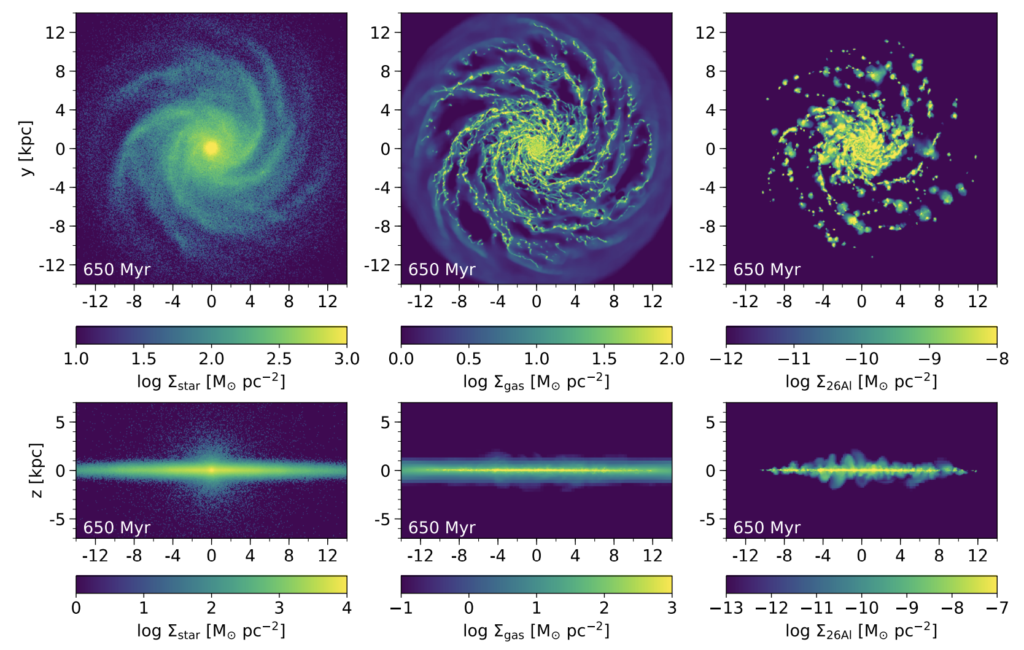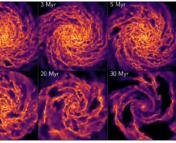Title: Distribution and kinematics of 26Al in the Galactic disc
Authors: Yusuke Fujimoto, Mark R. Krumholz, Shu-ichiro Inutsuka
First Author’s Institution: Earth and Planets Laboratory, Carnegie Institution for Science
Status: Submitted to MNRAS [open access]
Most people know that aluminum is very useful for cooking an excellent steak or holding your favorite soft drink. Remarkably, it can also help us trace past supernova explosions and star formation in a galaxy! One of the isotopes of aluminum, aluminum-26 (Al-26), is produced in the cores of massive stars through fusion. These atoms are then expelled into the interstellar medium via stellar winds and supernovae. Al-26 is also radioactive with a very short half-life, meaning that, wherever we find Al-26, star formation and supernovae must have recently happended.
Today’s paper conducts a Milky Way-like galaxy simulation to study two mysteries that have emerged from recent observations of Al-26 in our own galaxy:
- Al-26 has a scale height of nearly 800 parsecs above the galactic plane, almost an order of magnitude greater than the 50 parsec scale height of both stars and star-forming gas.
- The mean rotation speed of Al-26 is 100-200 km/s greater than the rest of the galactic disk.
Given the importance of Al-26 as a tracer of stellar feedback, solving these mysteries could yield many more insights about the process of galaxy evolution.
A Tale of Two Hypotheses
So far, two major hypotheses for these discrepancies have emerged in the literature. The first argues that the spiral arms in the Milky Way are relatively permanent, so they will sweep up material as they rotate around the galaxy. This “swept up” material will then cause stars to preferentially form at the front of a spiral arm. Sitting at the front, these stars will see low-density material in front of them and a high-density spiral arm behind them. Consequently, material like Al-26 that is ejected through stellar winds or supernovae can most easily move out ahead of the spiral arm and maintain a faster rotational velocity, addressing mystery #2. This material will also be able to expand into the low-density material in front of the arm, yielding a larger scale height and a potential answer to mystery #1.
The second hypothesis argues that, since there is evidence the solar system is actually located within a large bubble, the mysteries may be the result of the projection effects from nearby Al-26 structures instead (Fig 1). This would mean that the large scale height and rotational velocities are simply the result of variations in the Al-26 distribution close to the sun. The authors of today’s paper note that recent observational evidence suggests that the picture of star formation in the first hypothesis is incorrect and star formation proceeds in transient spiral arms, so they set out to test the second hypothesis using more realistic and sophisticated simulations that produce such spiral arm behavior.
Generating a Galaxy

To ensure that their simulation reaches realistic conditions, the authors evolve their galaxy for 650 million years, by which time their star formation has reached a steady state. Snapshots of their galaxy at this time are shown in Figure 2. One can see that they do not recover a large scale height for Al-26, instead obtaining a scale height roughly consistent with that of the cold gas. Furthermore, they do not observe any large difference in rotational velocity between the gas and Al-26. In other words, neither mystery is solved by including more physics that better match observations. This leads the authors to consider looking at the data from inside a bubble of Al-26 in accordance with hypothesis #2.

When one looks at the simulation data from inside a bubble of Al-26, two interesting features can be observed (Fig 3). First, the Al-26 appears to have a much larger scale height than the galactic distribution as a whole. Second, more of the Al-26 reaches higher rotational velocities than if the Al-26 was viewed from outside of a bubble. The authors argue that this may present evidence that the mysteries of Al-26 observations can be explained by the fact that the Sun resides in a local bubble. However, it is important to note that the authors only observe some Al-26 moving at higher velocities under these conditions; they do not observe a systematic 100-200 km/s offset compared with the rest of the galaxy as described in mystery #2. At this point, it is difficult to say whether there is something wrong with our models or if our solar system just happens to reside in a unique spot. Consequently, it appears that while aluminum may not foil our understanding of galaxy evolution, it still presents at least one intriguing mystery that will teach us something new about our place in the galaxy.





“while aluminium may not foil our understanding…” . Hur. Hurhur. Hurhurhurhur…
That was a nicely written summary!
Thanks a lot!